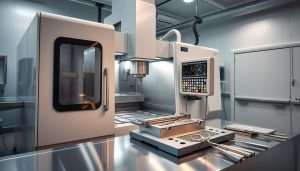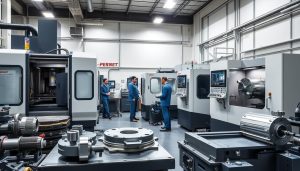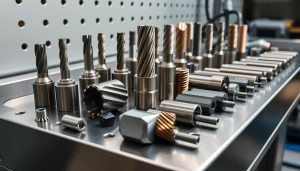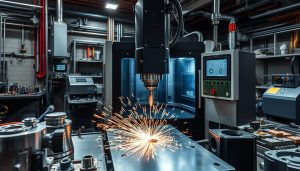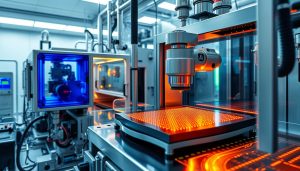In the realm of modern manufacturing, 5-axis CNC machining has emerged as a game-changing technology that is revolutionizing the way complex parts are produced. This advanced manufacturing process offers unparalleled precision, efficiency, and the ability to create intricate components that were once considered impossible to manufacture. By leveraging the power of five-axis motion, manufacturers can now tackle even the most challenging geometries with remarkable accuracy and speed.
Unlike traditional three-axis CNC machining, which is limited to movements along the X, Y, and Z-axes, 5-axis CNC machines introduce two additional rotational axes, allowing for greater flexibility and control over the workpiece. This enhanced capability enables manufacturers to create parts with complex shapes, deep cavities, and undercuts that would be extremely difficult or even impossible to produce using conventional methods.
Key Takeaways
- 5-axis CNC machining is an advanced manufacturing technology that offers unprecedented precision and flexibility in creating complex parts.
- It utilizes five axes of motion (three linear and two rotational) to tackle intricate geometries that traditional three-axis CNC machines cannot handle.
- 5-axis machining enhances productivity, reduces lead times, and enables the production of high-quality, custom-made components for various industries.
- This technology is widely adopted in sectors such as aerospace, automotive, medical devices, and electronics, where the demand for complex and precise parts is ever-increasing.
- Understanding the capabilities and benefits of 5-axis CNC machining is crucial for manufacturers seeking to stay at the forefront of modern manufacturing techniques.
Understanding 5-Axis CNC Machining
The world of advanced manufacturing has seen a remarkable evolution with the introduction of 5-axis CNC (Computer Numerical Control) machining. This innovative technology has transformed the way intricate parts and components are produced, offering unparalleled precision and efficiency.
What is a 5-Axis CNC Machine?
A 5-axis CNC machine is a highly sophisticated tool that can move along five different axes simultaneously. Unlike traditional 3-axis machines, which are limited to movement in the X, Y, and Z directions, 5-axis CNC machines can also rotate around the A and B axes, allowing for complex part creation in a single setup.
How Does 5-Axis CNC Machining Work?
The 5-axis CNC machining process leverages the machine’s ability to move and rotate the workpiece in multiple directions. This enables the cutting tool to access hard-to-reach areas and create intricate geometries that would be challenging or even impossible to achieve with conventional 3-axis machining.
The Key Benefits of 5-Axis Machining
The adoption of 5-axis CNC technology has brought about a host of advantages for manufacturers across various industries, including:
- Improved part quality and precision
- Reduced lead times and overall production costs
- Enhanced design flexibility, enabling the creation of more complex parts
- Increased productivity and efficiency through fewer setups and operations
- The ability to machine parts with undercuts, complex angles, and difficult-to-reach surfaces
By harnessing the power of 5-axis CNC machining, manufacturers can unlock new possibilities in advanced manufacturing processes, pushing the boundaries of what is achievable in industries such as aerospace, automotive, and medical device production.
Types of 5-Axis CNC Machines
The world of 5-axis CNC machining offers a diverse range of specialized equipment, each designed to cater to unique manufacturing needs. Let’s explore the key differences between the various types of 5-axis CNC machines and how they compare to traditional CNC equipment.
Simultaneous vs. 3+2 Axis Machining
Simultaneous 5-axis machining involves the seamless coordination of all five axes (X, Y, Z, A, and B) to produce complex parts in a single setup. This advanced technique enables continuous motion and uninterrupted cuts, resulting in exceptional precision and efficiency. In contrast, 3+2 axis machining utilizes three linear axes and two rotary axes, but these axes operate in a sequential manner, rather than simultaneously.
Vertical vs. Horizontal 5-Axis Machines
The orientation of the machine’s spindle is the primary distinction between vertical and horizontal 5-axis CNC machines. Vertical 5-axis machines feature a vertically-oriented spindle, which is ideal for machining parts with complex shapes and deep cavities. Horizontal 5-axis machines, on the other hand, have a horizontally-oriented spindle, making them well-suited for larger workpieces and parts with extended reach requirements.
Differences Between 5-Axis Machines and Traditional Machines
Traditional CNC machines, such as 3-axis and 4-axis models, are limited in their ability to access and machine complex geometries. 5-axis CNC machines, however, offer a significant advantage by providing the additional rotational axes required to reach and machine these intricate parts with a high degree of precision. This expanded capability allows for the production of more complex components, particularly in industries like aerospace, automotive, and medical device manufacturing.
| Feature | Traditional CNC Machines | 5-Axis CNC Machines |
|---|---|---|
| Axes of Movement | 3-axis or 4-axis | 5-axis (X, Y, Z, A, B) |
| Machining Capabilities | Limited to simpler geometries | Capable of producing complex, intricate parts |
| Precision | Moderate | Exceptionally high |
| Efficiency | Requires multiple setups | Single-setup machining for complex parts |
By understanding the distinctions between these 5-axis CNC machine types and their advantages over traditional equipment, manufacturers can make informed decisions about the best-suited technology for their specific production needs.

Applications of 5-Axis CNC Machining
5-axis CNC machining has revolutionized the manufacturing landscape, enabling industries to push the boundaries of production and innovation. This advanced technology finds its applications across a diverse range of sectors, from aerospace components and automotive parts to medical device manufacturing and electronics fabrication.
Precision Parts for Aerospace and Automotive Industries
Aerospace components and automotive parts demand the utmost precision and quality. 5-axis CNC machining excels in delivering intricate, complex geometries that are crucial for these industries. Manufacturers can create highly customized, lightweight, and durable parts with unparalleled accuracy, meeting the stringent requirements of aerospace and automotive applications.
Complex Components in Medical Devices and Electronics
The medical device and electronics industries often require the production of intricate, miniaturized components. 5-axis CNC machining shines in this domain, allowing manufacturers to fabricate complex shapes and features with exceptional precision. From delicate medical implants to sophisticated electronic housings, this technology enables the creation of high-performance, reliable parts that are essential for these sectors.
Prototyping and Custom Fabrication
Beyond production, 5-axis CNC machining is invaluable for prototyping and custom fabrication. Its versatility allows designers and engineers to quickly bring their ideas to life, testing and refining their concepts with unparalleled speed and flexibility. This technology empowers innovation by enabling the creation of one-off pieces or small-batch production runs, catering to the unique needs of various industries.
| Industry | Application |
|---|---|
| Aerospace | Precision components for aircraft, spacecraft, and satellites |
| Automotive | Intricate parts for engines, transmissions, and suspension systems |
| Medical Devices | Complex implants, surgical instruments, and prosthetic components |
| Electronics | Intricate housings, casings, and enclosures for electronic devices |
5-axis CNC machining has become an indispensable tool for modern manufacturing, empowering industries to push the boundaries of what is possible. By leveraging this advanced technology, companies can create precision parts, complex components, and custom fabrications that are essential for driving innovation and meeting the demands of the aerospace, automotive, medical device, and electronics sectors.

Why Choose Shixinproto for Your 5-Axis CNC Machining Needs
At Shixinproto, we take pride in our expertise in 5-axis CNC machining services. As a leading precision manufacturing partner, we have the advanced equipment, skilled technicians, and unwavering commitment to quality that you can trust for your most demanding projects.
Our state-of-the-art 5-axis CNC machines allow us to tackle complex geometries and create intricate parts with unparalleled precision. From aerospace and automotive components to medical devices and electronics, we have the capabilities to handle a wide range of industries and applications. Shixinproto’s extensive experience in 5-axis machining ensures that your parts will be produced to the tightest tolerances, every time.
When you choose Shixinproto as your 5-axis CNC machining partner, you can expect personalized attention, innovative solutions, and a relentless focus on delivering exceptional results. Our team of experts will work closely with you to understand your unique requirements and tailor our services to meet your specific needs. Discover why Shixinproto is the trusted choice for precision manufacturing across the United States.
